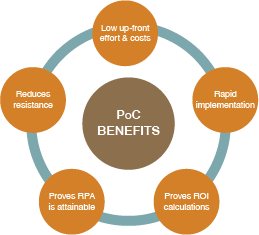How to choose a Proof of Concept (PoC) process for robotic process automation
A proof of concept (POC) for Robotic Process Automation (RPA) demonstrates real business value by offering low-risk implementation with limited cost.
Reading time: 3 minutes

Robotic Process Automation, or RPA, is a technology that allows businesses and organizations to configure software Robots to conduct routine, rules-based computer tasks—much like a human employee would.
Robots can fill out documents, read and send emails, enter data into business applications, and much more. When deployed properly, they help business units improve efficiency and empower people to use their unique talents to add value and create positive outcomes. The challenge for most organizations is not deciding whether or not RPA will generate a return on investment but instead where to start the RPA journey. For those with this question, the answer is a Proof-of-Concept (PoC) process.
WHY DO A PoC?
A PoC process allows for the implementation of RPA with minimal effort and limited cost. It focuses on a process small in scope and involves only one department. This promotes adoption by letting a targeted group of employees get familiar with automation and its benefits, which helps overcome the natural resistance to change.

Automation is not about changing processes. Rather, automation is a mindset…a way of looking at processes and thinking about ways to complete them faster, more accurately, and without unnecessary human resources.
Naturally, certain processes are better fits for RPA than others. A PoC helps you identify processes that are the best candidates for RPA and can be completed in as little as 5 weeks. The PoC is then used as a benchmark for ROI calculations when evaluating other RPA prospects.
HOW TO SELECT A PoC
There are four main steps to selecting a PoC:
- Find a department with a willing champion
- Brainstorm which processes are ripe for automation
- Complete the Garnet QuickStart Process Assessment
- Analyzing results and recommending a process with the right mix of effort-to-value
To start, you need to decide what department may benefit most from RPA. Both HR and Finance often have a significant amount of potential value gain via automation. However, it is just as—if not more—important to find a department with a willing champion for RPA. Many organizations will simply view automation as an IT exercise, which can set them up for low adoption rates and less invested business partners. This champion should be knowledgeable with multiple areas of the department and should have decision making power.
Next, work with this champion to determine which processes may be a good automation candidate. For now, this assessment does not need to be detailed. Collect processes that have the following characteristics:
- Repetitive
- Significant manual work
- Rules based decision points (or no decisions at all)
- Low number of exceptions

Once you have this set of processes, you can fill out a Process Assessment for each process. At Garnet River, we have a QuickStart Process Assessment.. This assessment should be a simple form that helps quantify the process and compare it against other candidates. Each process is ranked based on three areas—complexity, savings, and business impact.
Finally, review the processes comparison. At this point, your RPA partner can and should recommend a PoC process. The recommended process will depend upon how aggressively your organization is pursuing RPA, how much time the process SMEs have, and how visible the automation will be across your organization. The goal of a PoC is to prove to your organization that RPA is attainable, and your RPA partner should prioritize this. The risk to an organization is low with a PoC. The potential benefits, if done right, are vast, scalable, and lasting.
About Garnet River
Founded in 2000 and based in Saratoga Springs, N.Y., Garnet River provides comprehensive and flexible staffing and staff augmentation services, innovative robotic process automation (RPA), and managed outsource solutions to public- and private-sector clients. Garnet River is a partner with UiPath, Microsoft, Cisco Meraki, Hewlett Packard Enterprise, and others. For more information, visit garnetriver.com.


